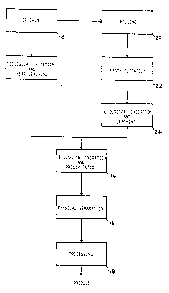Une partie des informations de ce site Web a été fournie par des sources externes. Le gouvernement du Canada n'assume aucune responsabilité concernant la précision, l'actualité ou la fiabilité des informations fournies par les sources externes. Les utilisateurs qui désirent employer cette information devraient consulter directement la source des informations. Le contenu fourni par les sources externes n'est pas assujetti aux exigences sur les langues officielles, la protection des renseignements personnels et l'accessibilité.
L'apparition de différences dans le texte et l'image des Revendications et de l'Abrégé dépend du moment auquel le document est publié. Les textes des Revendications et de l'Abrégé sont affichés :
| (12) Brevet: | (11) CA 2065491 |
|---|---|
| (54) Titre français: | RECUPERATION DE METAL |
| (54) Titre anglais: | METAL RECOVERY |
| Statut: | Durée expirée - au-delà du délai suivant l'octroi |
| (51) Classification internationale des brevets (CIB): |
|
|---|---|
| (72) Inventeurs : |
|
| (73) Titulaires : |
|
| (71) Demandeurs : |
|
| (74) Agent: | SMART & BIGGAR LP |
| (74) Co-agent: | |
| (45) Délivré: | 2003-07-08 |
| (22) Date de dépôt: | 1992-04-07 |
| (41) Mise à la disponibilité du public: | 1992-10-09 |
| Requête d'examen: | 1999-04-06 |
| Licence disponible: | S.O. |
| Cédé au domaine public: | S.O. |
| (25) Langue des documents déposés: | Anglais |
| Traité de coopération en matière de brevets (PCT): | Non |
|---|
| (30) Données de priorité de la demande: | ||||||
|---|---|---|---|---|---|---|
|
A method of extracting metal from sulphide ores, which includes the steps
of solubilizing the metal into a sulphate solution, and generating sulphide
by anaerobic bacterial action in the sulphate solution, thereby to cause
the metal in the solution to be precipitated as an insoluble sulphide, thus
upgrading the metal into a highly concentrated form.
Note : Les revendications sont présentées dans la langue officielle dans laquelle elles ont été soumises.
Note : Les descriptions sont présentées dans la langue officielle dans laquelle elles ont été soumises.

2024-08-01 : Dans le cadre de la transition vers les Brevets de nouvelle génération (BNG), la base de données sur les brevets canadiens (BDBC) contient désormais un Historique d'événement plus détaillé, qui reproduit le Journal des événements de notre nouvelle solution interne.
Veuillez noter que les événements débutant par « Inactive : » se réfèrent à des événements qui ne sont plus utilisés dans notre nouvelle solution interne.
Pour une meilleure compréhension de l'état de la demande ou brevet qui figure sur cette page, la rubrique Mise en garde , et les descriptions de Brevet , Historique d'événement , Taxes périodiques et Historique des paiements devraient être consultées.
| Description | Date |
|---|---|
| Inactive : Périmé (brevet - nouvelle loi) | 2012-04-07 |
| Inactive : CIB de MCD | 2006-03-11 |
| Inactive : CIB de MCD | 2006-03-11 |
| Accordé par délivrance | 2003-07-08 |
| Inactive : Page couverture publiée | 2003-07-07 |
| Inactive : Taxe finale reçue | 2003-04-07 |
| Préoctroi | 2003-04-07 |
| Un avis d'acceptation est envoyé | 2002-12-12 |
| Lettre envoyée | 2002-12-12 |
| Un avis d'acceptation est envoyé | 2002-12-12 |
| Inactive : Approuvée aux fins d'acceptation (AFA) | 2002-11-28 |
| Modification reçue - modification volontaire | 2002-10-03 |
| Inactive : Dem. de l'examinateur par.30(2) Règles | 2002-04-04 |
| Modification reçue - modification volontaire | 2000-03-07 |
| Inactive : Dem. traitée sur TS dès date d'ent. journal | 1999-04-22 |
| Lettre envoyée | 1999-04-22 |
| Inactive : Renseign. sur l'état - Complets dès date d'ent. journ. | 1999-04-22 |
| Toutes les exigences pour l'examen - jugée conforme | 1999-04-06 |
| Exigences pour une requête d'examen - jugée conforme | 1999-04-06 |
| Inactive : Demandeur supprimé | 1997-10-27 |
| Réputée abandonnée - omission de répondre à un avis sur les taxes pour le maintien en état | 1997-04-07 |
| Inactive : Demande ad hoc documentée | 1997-04-07 |
| Demande publiée (accessible au public) | 1992-10-09 |
| Date d'abandonnement | Raison | Date de rétablissement |
|---|---|---|
| 1997-04-07 |
Le dernier paiement a été reçu le 2003-03-31
Avis : Si le paiement en totalité n'a pas été reçu au plus tard à la date indiquée, une taxe supplémentaire peut être imposée, soit une des taxes suivantes :
Veuillez vous référer à la page web des taxes sur les brevets de l'OPIC pour voir tous les montants actuels des taxes.
Les titulaires actuels et antérieures au dossier sont affichés en ordre alphabétique.
| Titulaires actuels au dossier |
|---|
| GENERAL MINING, METALS AND MINERALS LIMITED |
| BILLITON INTELLECTUAL PROPERTY B.V. |
| Titulaires antérieures au dossier |
|---|
| ALAN KEITH HAINES |